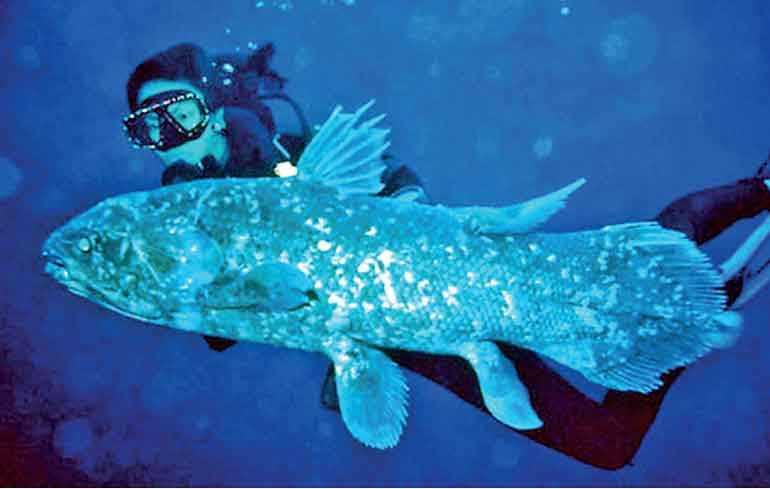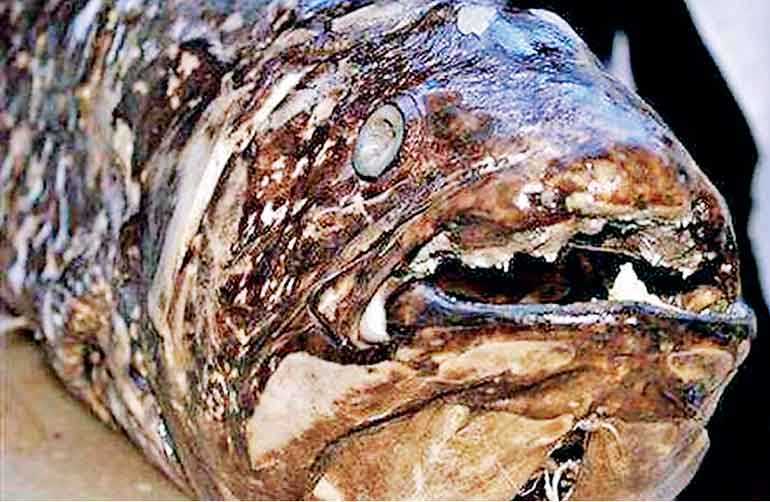Monday Mar 03, 2025
Monday Mar 03, 2025
Saturday, 27 June 2020 00:01 - - {{hitsCtrl.values.hits}}

An Indonesian coelacanth and Arnaz Mehta Erdmann, at about a 50-foot depth – Pic by Mark V. Erdmann
A coelacanth, an ancient fish once thought to have become extinct when it disappeared from fossil records 80 million years ago, is shown in Nairobi, Kenya, in this 21 November 2001 file photo. Fishermen in Zanzibar have caught a coelacanth, an official said last week – Reuters
Imagine a life form so ancient, older than the dinosaurs, lurking in the dark waters close to the ocean bed. An animal so stubborn, it survived 400 million years without evolving. That is the story of the living fossil known as the Coelacanth.
Since 95% of the ocean floor is uncharted territory, it shouldn’t be hard to imagine this but it seems mankind needed a motive to fully perceive this possibility. This came in the form of a bizarre fish that washed up on a fishing trawler due to a storm off the coast of East London, South Africa in December 1938.
The fish was brought to the curator of East London museum, Marjorie Courtenay Latimer, who contacted her friend, James Leonard Brierley Smith, who was a chemist but has a passion in Ichthyology. He informed her that he would be there in two months’ time. The fish was stuffed and mounted to preserve the outer form.
Smith was the first to identify the taxidermied fish as a species of Coelacanth not too like the prominent fossilised species. And so, he received the chance to name it. It was called Latimeria Chalumnae, the West Indian Ocean Coelacanth. He made it his ultimate goal to capture another specimen and study it, which he did 14 years later. This was a magnificent contribution to the study of Coelacanths and to science as a whole.
In 1998, a Coelacanth was found off the coast of Sulawesi, Indonesia. This specimen turned out to be a different species and was named Latimeria Menadoensis, the Indonesian Coelacanth. Thus, it was concluded that these are the two extant species of Coelacanth. The West Indian Coelacanth is labelled as critically endangered whereas its Indonesian counterpart is vulnerable. Despite being one of the most studied vertebrates, little is known about the Coelacanth’s growth rate, mating and hunting habits and so on.
They live in caves at depths ranging from 300 feet to 700 feet, resting there during the day and hunting at night. There aren’t any Coelacanths in aquariums because they are incapable of harbouring a sensitive organism such as it. Extraction and transportation of the creature is too risky. They live in cold water, dropping lower from 18 degrees Celsius, whereas the surface temperatures reach 24 to 26 degrees.
The fish is used to high pressure and a higher oxygen concentration in the water and has a very low metabolism. Warmer water has less dissolved oxygen, increases the fish metabolism rapidly and causes it to suffocate. The sudden change in temperature, pressure and the panic of capture may also bring about a condition known as bends or DCS, one which human divers suffer from. The gases dissolved in its tissues will get released into its bloodstream and cause bubbles. The specimen may die of pain.
The Coelacanth is unsuitable for any sort of consumption for most animals, including humans as its flesh is concentrated with chemical compounds that are difficult to digest and is extremely waxy. Its key features are its hinged joints dividing its upper skull into halves, a hollow spinal tube, lobed fins and its distinctive tail fin. It gives birth to live young, incubating its offspring within itself. Its eyes are best suited for seeing in poor lighting. The Coelacanths have many similarities with sharks, like the rostral organ that some sharks have which contain cells that act like electroreceptors to help them hunt.
The Coelacanth’s locomotion is similar to the tetrapods, as in, synchronised fin movement to propel itself. Its left pelvic fin and its right pectoral fins move in sync and vice versa. It was once theorised that the Coelacanth is the missing link between sea and land, our direct ancestor from the ocean. The hypothesis stated that it crawled onto land and was the first tetrapod (an animal that mobilises itself with four limbs). This idea has since been disposed of.
This living fossil has altered the direction of science and changed the lives of the lucky few who have encountered it. It is an example of Charles Darwin’s explanation of how certain animals may escape the pressure to evolve and has proved itself to be among the most elusive of creatures man has ever stumbled upon. It will stand by its title as the ‘dinofish that evaded extinction’.
Discover Kapruka, the leading online shopping platform in Sri Lanka, where you can conveniently send Gifts and Flowers to your loved ones for any event including Valentine ’s Day. Explore a wide range of popular Shopping Categories on Kapruka, including Toys, Groceries, Electronics, Birthday Cakes, Fruits, Chocolates, Flower Bouquets, Clothing, Watches, Lingerie, Gift Sets and Jewellery. Also if you’re interested in selling with Kapruka, Partner Central by Kapruka is the best solution to start with. Moreover, through Kapruka Global Shop, you can also enjoy the convenience of purchasing products from renowned platforms like Amazon and eBay and have them delivered to Sri Lanka.
Discover Kapruka, the leading online shopping platform in Sri Lanka, where you can conveniently send Gifts and Flowers to your loved ones for any event including Valentine ’s Day. Explore a wide range of popular Shopping Categories on Kapruka, including Toys, Groceries, Electronics, Birthday Cakes, Fruits, Chocolates, Flower Bouquets, Clothing, Watches, Lingerie, Gift Sets and Jewellery. Also if you’re interested in selling with Kapruka, Partner Central by Kapruka is the best solution to start with. Moreover, through Kapruka Global Shop, you can also enjoy the convenience of purchasing products from renowned platforms like Amazon and eBay and have them delivered to Sri Lanka.